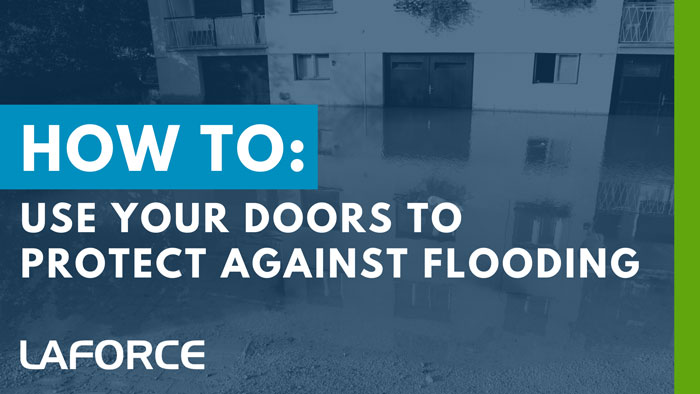Weather is changing and flooding is becoming a more frequent and intense problem across the country. Floods are also one of the most damaging and costly natural disasters, and they can happen quickly, leaving you little time to prepare. At LaForce, we have proactive solutions such as flood shields and flood doors, that can help protect your building from being flooded.
Flood Shield
A flood shield is a cost-effective way to help prevent water from flooding into your building because it is retrofitted to your existing door and frame. When there is a risk for flooding, the flood shield is easily installed into the guides that have been retrofitted to your frame. There is a spring mechanism that maintains constant tension against the gasketing to create a solid flood barrier, keeping floodwaters from reaching your door and penetrating your building. It is important when retrofitting the flood shield to make sure your frame is sealed to the walls of your building and that you have a surface that is smooth, even, clean, and flat for the flood shield to seal against. If you do not, adding a threshold is recommended so that you get a good seal when deploying the flood shield.
This is an “active” flood system, which means it requires human intervention to deploy. However, flood shields are easy to deploy; they can be engaged by one person. Flood shield systems can also be customized for an opening size up to 8 feet wide and come in 10-, 22- and 34-inch heights. Flood shields allow for a small amount of water leakage, but these systems comply with FEMA and FIMA guidelines for use on doors in flood-prone areas.
Flood Doors
Flood-resistant door systems are designed to prevent floodwater from entering your building. These systems are a great option if you are worried about rising floodwater pushing against your exterior doors, or if you have a building/room that could be easily damaged by water but still needs to be accessible (pump rooms, electrical/data centers, manufacturing floors, warehouses, etc.). Flood doors allow for a small amount of water leakage, but not enough to cause severe damage to the building’s interior; they still help to minimize damage compared to a non-flood resistant door and comply with FEMA and FIMA guidelines.
Flood doors are “passive” systems, meaning that you don’t have to activate them during a flood; they are constantly protecting your facility as long as the door is closed and maintained. These systems are engineered to withstand hydrostatic pressure caused by floodwater pushing against the opening. Their integrity will not be compromised by flooding as long as the water level does not exceed the designated maximum water level.
When ordering a flood-resistant door system, we need to know:
• the side of the door the potential floodwater is on
• the size of the opening
• whether the opening needs to be ADA compliant
If floodwaters are on the pull side of the door, the flood door system will push (or “seat”) the door against the seals as the floodwater rises. Any hardware can be used with a seated system as long as it is located completely above the expected water level. Although seated systems are most common, there are solutions for push doors as well (unseated systems). In an unseated system, pressure from the floodwater pushes the door away from the seals, which means the hardware must hold the door against the seals as the water level rises. For this reason, the hardware for unseated systems is limited and must be supplied by the flood door manufacturer.
If you are interested in taking the steps to protect your building and assets from damaging floodwaters, contact the experts at LaForce. We can help you decide on the flood protection system that is right for you and your building, whether you are looking for something passive or active.



Follow Us